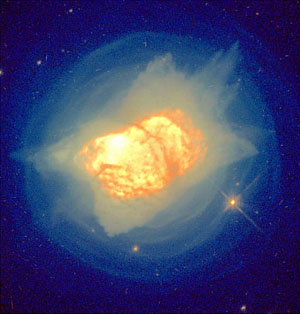 NGC
7027 is a small, relatively bright planetary nebula that is a
delight in just about any telescope. It has been a favorite
planetary of mine since my first observation with my 6-inch
Newtonian in 1977. This is also a very interesting planetary from a
science standpoint because it is actually a rare class of object
called a proto-planetary nebula. NGC
7027 is a small, relatively bright planetary nebula that is a
delight in just about any telescope. It has been a favorite
planetary of mine since my first observation with my 6-inch
Newtonian in 1977. This is also a very interesting planetary from a
science standpoint because it is actually a rare class of object
called a proto-planetary nebula.
In a 6-inch at 50x NGC
7027 looks like a 9th magnitude star. At higher magnifications it
has a slight oval shape. Experienced observers may be able to tell
that there is something "funny" about it. For the best
view use as much magnification as your telescope and sky conditions
will permit. At 270x it is clearly oval in shape. I noted that it
appeared brighter at the northwest end.
More
recently, and armed with my 18-inch f/4.5 Dob and an OIII filter, I
was amazed at the sight that greeted me at 430x. Fantastic! All my
previous logs describe an elongated, egg shape. But this night it
appeared as a green rectangle with soft edges. The northwest quarter
appeared brighter and within it, near the long edge, could be seen
at least two tiny bright knots! Unfortunately I didn't think to look
for the 16th magnitude central star. In short, it looked very much
like the image at the top of the page, only with much less detail.
Time
and time again I've discovered detail in planetaries with this scope
that had not previously been visible--more than that, I didn't
believe they were visible--in any scope! Those of you with
large Dobs who haven't discovered planetaries should give some of
these a try. To my mind there is no better example of the advantages
of a large Dob. For best results I use high magnification (at least
400x and as much as 50x per inch or aperture or more depending on
the seeing conditions and the surface brightness of the object).

The field in a 6-inch
telescope at 50x. North is down and East is right.
NGC 7027 appears to be
a proto-planetary nebula; a very young object intermediate between a
pulsating giant star and a true planetary nebula. The central star
at the root of all this was a pulsating giant as recently as a few
thousand years ago, a blink of an eye on cosmic time scales. As the
star aged it swelled to many times its previous diameter, became
much brighter, and began to pulsate. These pulsations drove material
away from the star in concentric shells. This material is made of
molecules such as hydrogen and carbon monoxide and is relatively
cool. As the central star continued to evolve it became much hotter,
producing ionizing ultraviolet radiation. The central star currently
is as hot as 200,000K and shines some 5000 times brighter than the
sun! This radiation breaks up the molecules of the surrounding gas
into their constituent atoms, a process that takes only a few
thousand years. The atoms then become ionized (lose one or more
electrons) as they absorb the ultraviolet light. It is this final
stage of a star surrounded by ionized, glowing, gas that we call a
planetary nebula. The presence of molecules in the spectrum of NGC
7027 indicates that we have caught it in the short lived process of
becoming a planetary; a rare proto-planetary nebula.
NGC
7027 Links:
Staring
Into the Winds of Destruction
|